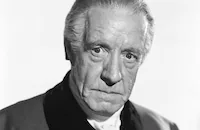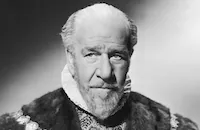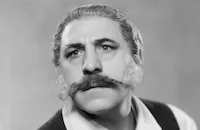A popular conception for many years was that red hair on a woman was the sign of a wild spirit and a freewheeling, often aggressive sexuality. Redheads in films were also often loose-moraled femmes fatales with dangerous intentions. Lil Andrews, the central character of this deliciously wicked pre-Code film, is a little bit of all those things. Lil makes a play for her boss, Bill Legendre, who becomes so obsessed with the seductive stenographer's sensuality, he divorces his wife and marries her. But wedded bliss isn't in store for the couple. Lil resents being looked down on by her husband's high-society crowd and carries on affairs with two other men, one of them her French chauffeur. Legendre is almost killed by Lil when he confronts her and her lovers, and soon he returns to his forgiving first wife. The end for Lil? Not quite. Years later on a trip abroad, the Legendres come upon the home wrecker again, successfully playing higher stakes (and dallying with more than one man) in a new elite crowd.
Based on a story by popular "wicked-lady" novelist Katherine Brush, Red-Headed Woman had all the makings of either a lurid morality tale or dreary tragic soap opera. In fact, that's exactly what it might have been if left in the hands of its original adapter, F. Scott Fitzgerald. The premier chronicler of the Jazz Age was, by the early 30s, already heavily into the bad drinking problem that would eventually kill him and no longer a hot commodity in the publishing industry. He had been working as a screenwriter for several years, although not with great success, and his script for this picture did nothing to advance his fortunes or reputation. According to writer Anita Loos in her 1974 autobiography Kiss Hollywood Goodbye, MGM production chief Irving Thalberg brought her onto the project because, he said, "Scott tried to turn the silly book into a tone poem!" and he wanted her to have fun with the sexual element of the story, as she did in her hit 1920s play Gentlemen Prefer Blondes. Loos set about crafting a saucy, candid comedy from the material.
The big question, then, was who to cast? To make the whole thing fly, they needed an actress who could be convincingly sexy and scheming while having enough comic appeal to keep the audience from hissing her off the screen as an evil villain. Every actress on the MGM lot had been briefly considered for the role and rejected. Garbo was too languid and continental, Joan Crawford too hard-edged and intelligent. Although a champion of the project, Thalberg wasn't about to assign his wife, Norma Shearer, to such an unsympathetic role, and newspaper mogul William Randolph Hearst took the same position when it came to his mistress and protégé, Marion Davies. (The story goes that even big, homely comic actress Marie Dressler donned a red wig and jokingly demanded a test.) Clara Bow, the free-spirited, red-haired flapper of the 20s was briefly considered, but her career was on the wane. That left Thalberg with the young starlet being pushed by his colleague Paul Bern Jean Harlow.
Harlow had attracted some notice in blonde bombshell roles in Howard Hughes' Hell's Angels (1930) and The Public Enemy (1931) but without exciting much enthusiasm, particularly among critics. The acclaimed playwright Robert Sherwood, who was then a film reviewer for Life magazine, called Harlow "an obstreperously alluring young lady...of whom not much is likely to be heard." But what Bern and Harlow knew was that she had a gift for comedy and an ambition to stretch beyond the usual femme fatale roles. Her work in Red-Headed Woman proved them right. Upon its release, it immediately catapulted her into stardom. Vanity Fair magazine chose it film of the year, and it was reported that the royal family of England had their own personal copy for entertaining dinner guests.
The movie, and Harlow, achieved another kind of notoriety as well. Guardians of public morals throughout the country were incensed not only by the film's frank treatment of sexuality but even more by the fact that Lil, an irredeemably bad girl who selfishly wrecks the lives of everyone around her, doesn't get any kind of comeuppance or learn her lesson by the end of the story. Rather, she ends up rich, happy and accepted by high society without ever having to pay for her sins. Because of this, Red-Headed Woman is often cited as one of the motion pictures that brought about more stringent censorship under the Production Code, ushering in an era of enforced "morality" and coy dodges around sex for decades to come.
There's another future star to watch for in this movie. The brief but key role of the chauffeur was assigned to Charles Boyer, then a young French actor on a six-month option to MGM. The studio didn't know how to use him because his accent was too thick to be understood, they said. With only a couple of weeks left on his option, they threw him into the picture and dropped him immediately afterward. But as Loos observed, "his actions were a lot more understandable than words." Audiences agreed wholeheartedly. In previews, the studio found so many pantingly appreciative comments from female viewers, Boyer was immediately called back from Paris and offered a contract at ten times the rate he had been paid on option.
Director: Jack Conway
Producer: Albert Lewin
Screenplay: Anita Loos, F. Scott Fitzgerald (uncredited)
Cinematography: Harold Rosson
Editing: Blanche Sewell
Art Direction: Cedric Gibbons
Cast: Jean Harlow (Lil Andrews), Chester Morris (Bill Legendre), Lewis Stone (William Legendre Sr.), Leila Hyams (Irene Legendre), Una Merkel (Sally), May Robson (Aunt Jane), Charles Boyer (Albert).
BW-80m. Closed captioning.
by Rob Nixon































